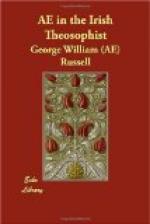The Serpentine Power is the couch of the sun, the casket of spirit. Hence the Druids or Magi who had mastered this power were called Serpents. Though St. Patrick is said to have driven the serpents out of Ireland, traces still remain of the serpent wisdom. Lest the interpretation given should seem arbitrary I will trace further explicit references to the third eye. Diarmuid, the hero and darling of so many story-tellers, whose flight with Grania forms one of the most mystic episodes in Celtic romance, is described as having a spot in the centre of his forehead which fascinated whoever gazed. He is called the “Son of the Monarch of Light.” He is the Initiate, the twice-born. This divine parentage has the sense in which the words were spoken. “Marvel not that I said unto thee, ye must be born again.” In the same sense a Druid is described as “full of his God.” From the mystic Father descends the Ray, the Child of Light. It is born in man as mind, not reasoning: earthly not sensual, but as the heaven-aspiring, thinking mind. In itself it is of the nature of fire. The man who knows it becomes filled with light, aye, he moves about in light within himself.
The following description of a giant, taken from the story of Diarmuid, refers to still another aspect of our occult nature.
“He has, but one eye only in the fair middle of his black forehead. .... He is, moreover, so skilled in magic that fire could not burn him, water could not drown him, and weapons would not wound him. ...... He is fated not to die until there be struck upon him three blows of the iron club he has. He sleeps in the top of that Quicken tree by night, and he remains at its foot by day to watch it. .... The berries of the tree have the virtues of the trees of faeryland.”
The Quicken tree is the network of nerves in the magnetic astral body. Readers of the Upanishads will remember the description of the arteries, thin as a hair split a thousand times, which proceed from the heart, and in which the Ego rests during deep sleep. It has just the same significance in the legend. The meaning will be still better understood by a comparison of the youthful Finn in his encounter with a similar one-eye Titan. There is a most interesting version of this in Curtin’s Irish Myths and Folk-Tales. Too long to quote in its entirety, the story runs as follows. Finn meets a giant who carries a salmon in his hand. This Titan has “but one eye as large as the sun in the heavens.” He gives the fish to Finn to cook. The moment the giant closed his eye he began to breathe heavily. “Every time he drew breath he dragged Finn, the spit, the salmon, and all the goats to his mouth, and every time drove a breath out of himself he threw them back to the places they were in before.” While Finn is cooking the salmon he burns it, and in trying to hide the blister he burns his thumb. To ease the pain he put his thumb between his teeth, and chewed it through




